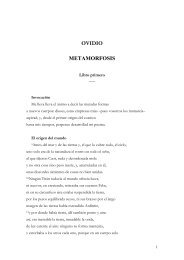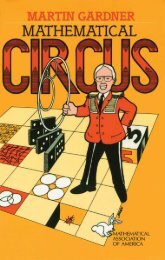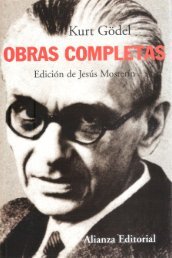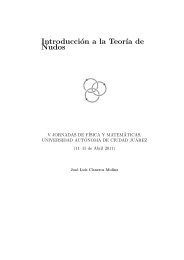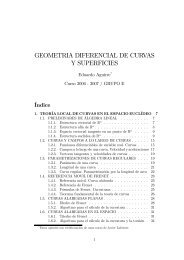Tao_T.-Analysis_I_(Volume_1)__-Hindustan_Book_Agency(2006)
Tao_T.-Analysis_I_(Volume_1)__-Hindustan_Book_Agency(2006)
Tao_T.-Analysis_I_(Volume_1)__-Hindustan_Book_Agency(2006)
Create successful ePaper yourself
Turn your PDF publications into a flip-book with our unique Google optimized e-Paper software.
2.2. Addition 29<br />
m)++· But by definition of addition, 0 + (m++) = m++ and 0 +<br />
m = m, so both sides are equal to m++ and are thus equal to each<br />
other. Now we assume inductively that n+(m++) = (n+m)++;<br />
wenowhavetoshowthat (n++)+(m++) = ((n++)+m)++. The<br />
left-hand side is (n + (m++ ))++ by definition of addition, which<br />
is equal to ((n+m)++ )++by the inductive hypothesis. Similarly,<br />
we have (n++ )+m = (n+m)++ by the definition of addition, and<br />
so the right-hand side is also equal to ((n+m)++)++. Thus both<br />
sides are equal to each other, and we have closed the induction. D<br />
As a particular corollary of Lemma 2.2.2 and Lemma 2.2.3 we<br />
see that n++ = n f 1 (why?).<br />
As promised earlier, we can now prove that a+ b = b +a.<br />
Proposition 2.2.4 (Addition is commutative). For any natural<br />
numbers n and m, n + m = m + n.<br />
Proof. We shall use induction on n (keeping m fixed). First we do<br />
the base case n = 0, i.e., we show O+m = m+O. By the definition<br />
of addition, 0 + m = m, while by Lemma 2.2.2, m + 0 = m. Thus<br />
the base case is done. Now suppose inductively that n+m = m+n,<br />
now we have to prove that ( n++) + m = m + ( n++) to close the<br />
induction. By the definition of addition, (n++) +m = (n+m)++.<br />
By Lemma 2.2.3, m + (n++) = (m + n)++, but this is equal to<br />
(n + m)++ by the inductive hypothesis n + m = m + n. Thus<br />
( n++) + m = m + ( n++) and we have closed the induction. D<br />
Proposition 2.2.5 (Addition is associative). For any natural<br />
numbers a, b, c, we have (a+ b)+ c =a+ (b +c).<br />
Proof. See Exercise 2.2.1. D<br />
Because of this associativity we can write sums such as a+b+c<br />
without having to worry about which order the numbers are being<br />
added together.<br />
Now we develop a cancellation law.<br />
Proposition 2.2.6 (Cancellation law). Let a, b, c be natural numbers<br />
such that a + b = a + c. Then we have b = c.



